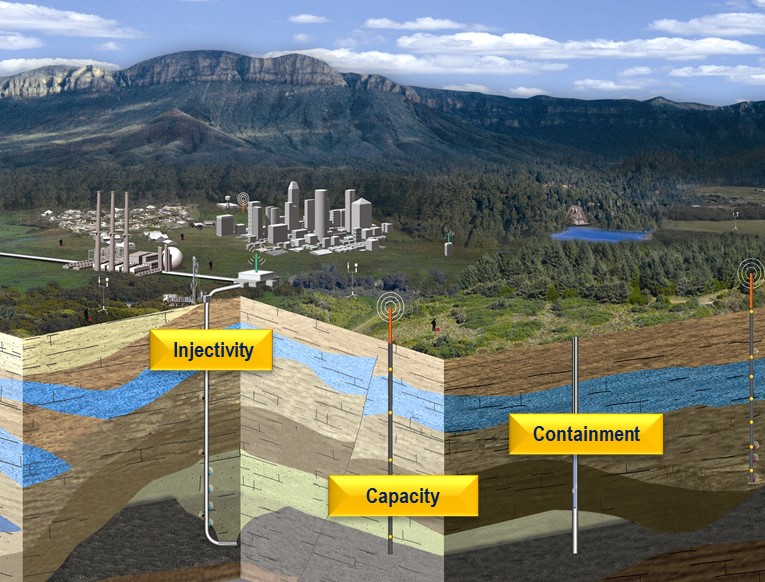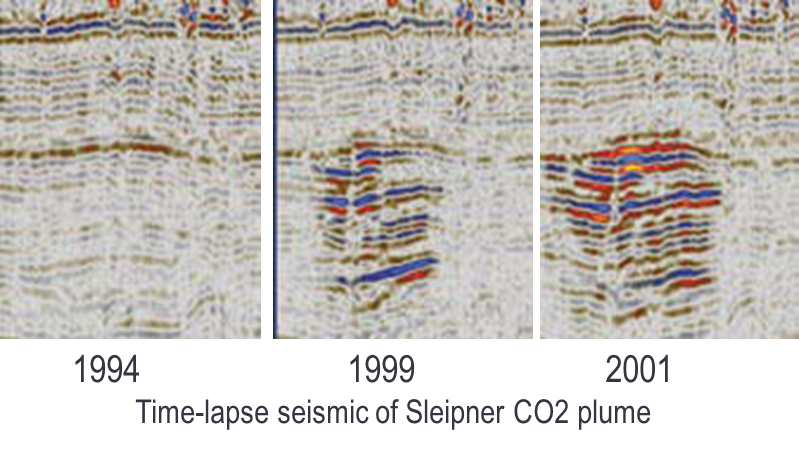Reservoir Simulation for CO2 Studies
Carbon capture, utilization and storage (CCUS) initiatives are making international headlines this year. Many governments are setting targets for carbon neutrality to be reached in the near future. Increasing numbers of oil and gas companies are announcing sustainability plans. Carbon dioxide (CO2)storage has the potential to contribute significantly to the reduction of greenhouse gases in the atmosphere, to help meet global clean energy targets.

CO2 can be captured from power stations, industrial sources such as cement factories and from natural gas production. It can be utilized in chemical processes, ranging from fertilizer to food production, and in enhanced oil recovery (EOR) and enhanced gas recovery (EGR), or it can be sequestered in geological structures, including saline aquifers, depleted oil and gas reservoirs and deep coal beds.
Key characteristics of a storage site include:
-
Capacity—how much CO2 can be stored?
-
Injectivity—what injection rates are possible?
-
Containment—what are the risks of leakage?
To answer these questions requires understanding of the complex physical and chemical behavior of CO2. It can be a component of hydrocarbon and aqueous phases. Above the critical point (temperature 31 °C, pressure 73.8 bar) pure CO2 exists as a supercritical dense phase, with gas-like viscosity and liquid-like density. Below the critical point it can exist as gas or liquid. Injected CO2 can become miscible with oil at high pressures. CO2 solubility in the aqueous phase depends on the reservoir conditions and brine composition: solubility increases with decreasing temperature and/or with increasing pressure and decreases with increasing brine salinity.

When CO2 is injected into a storage site such as a saline aquifer, it forms a gaseous plume that migrates underground, influenced by pressure gradients, gravity and buoyancy forces. The CO2 can be trapped by various mechanisms over different timescales.
-
Structural trapping—gaseous CO2 can be trapped by cap rock or structural features (important in injection and post-injection phases while gas is highly mobile)
-
Residual trapping—the gas phase is immobilized due to the effects of relative permeability and capillary pressure (important in injection and post-injection phases while gas remains mobile)
-
Solubility trapping—CO2 dissolves into the aqueous phase (a slower process that can take hundreds or thousands of years to complete)
-
Mineral trapping—the acid formed by CO2 dissolution reacts with the reservoir rock and mineral generation occurs (a long-term process that can take many thousands of years to complete)
The interactions between CO2, water, and salts affect not only solubility trapping and mineral trapping in the long term, but also injectivity due to near-wellbore behavior. As the gas is injected, H2O in brine evaporates into CO2 resulting in “dry-out” in the region near the injection well, when residual water saturation can reduce to zero. This increases the effective permeability to CO2 and injectivity increases. On the other hand, in high-salinity brine there is a risk of “salting-out” as H2O evaporates. Increasing salinity leads to halite precipitation: permeability and porosity reduce and so injectivity decreases.
Today, the total injection from worldwide CCUS projects is around 35 Mt/year, with typical projects storing around 1 Mt/year. However, future scenarios propose capturing a total of 1–5 Gt/year in the coming decades – how can such goals be achieved? It will require a rapid increase in CO2 storage activities, which will depend on selection of suitable sites, design of injection and monitoring strategies, and effective management of costs and risks.
It would be an overwhelming challenge to develop CO2 technologies in a short timescale, if research and implementation started from today. However, although experience is relatively limited in comparison with oil and gas production, CO2 storage has been evolving for more than 20 years, while use of CO2 for EOR started over 60 years ago. Schlumberger experts were early leaders in carbon capture and storage, providing integrated services from site selection, appraisal and planning, to operations and surveillance. We have developed proven solutions for CO2 projects, ranging from design and construction of observation wells to 4D seismic monitoring and dynamic simulation of storage scenarios.

Reservoir simulation is a vital component of the multi-disciplinary studies needed to answer those questions. Engineers need to study CO2 behavior over the lifetime of the project. This requires specialist features, as well as all the software functionality used for dynamic simulation of oil and gas fields. Schlumberger has tailored software options for storage applications, ready for use now, and we are evolving our capabilities to take advantage of the latest simulation and cloud technologies.
ECLIPSE Compositional simulator (E300) includes a rich set of dynamic simulation options for CO2 storage.
-
CO2STORE: designed for modeling geological storage of CO2 in saline aquifers. Three phases are considered: a CO2-rich gas phase, an H2O-rich aqueous phase and a solid phase. Mutual solubilities of CO2 and H2O are based on fugacity equilibration. Brine density is corrected for dissolved salt and CO2. The effects of halite and calcite precipitation and dissolution can be modeled using chemical reactions.
CO2STORE can also be used with ECLIPSE Thermal, with temperature- and pressure-dependent component K-values for phase equilibrium calculations. An oil phase can be defined in addition to the CO2-rich phase and H2O-rich phase, and the thermal properties of rock can be included in the model.
-
GASWAT: for CO2 injection in depleted gas reservoirs, for EGR and/or storage. This is a two-phase model which represents gas phase / aqueous phase equilibria using a modified Peng-Robinson equation of state. The gas composition can include CO2, N2, H2S, H2O and hydrocarbon gases. Aqueous phase coefficients, binary interaction components and salinity can be adjusted by the user to match observed lab or field data
-
CO2SOL: for three-phase compositional modeling of CO2 injection in depleted oil reservoirs, for EOR and/or storage. CO2 can be present in the oil, gas, and water phases, although H2O is not treated as soluble in the hydrocarbon phases. CO2 solubility in water is calculated using a fugacity function and depends on pressure, salinity, temperature, and composition.
The INTERSECT high-resolution reservoir simulator provides powerful performance for complex compositional cases with fine-resolution grids and is the recommended tool for CO2 EOR projects. New features for modeling chemical reactions were released this year and we are developing CO2 storage functionality in INTERSECT simulator.
For specialist analysis, we can use the extensibility features of the INTERSECT simulator to implement tailored calculations using Python scripts and/or interface with other software packages for geochemistry, geomechanics, etc. The run-time efficiency of the INTERSECT simulator will enable more detailed representation of the effects of heterogeneities on CO2 migration, as well as fast turn-around for multiple realizations in uncertainty studies.
Uncertainty is a major challenge in CO2 storage. Subsurface characterization data are relatively limited for deep saline aquifers, but quantification of risks is essential for storage projects, to design monitoring programs, optimize costs and satisfy regulations. The Petrel E&P software platform and MEPO multiple realization optimizer from Schlumberger support uncertainty and optimization (U&O) studies throughout the oil industry and are already used for CO2 studies. The Petrel platform workflows for constructing probability maps are based on original methods used in planning 4D seismic surveys for a CO2 injection project. Now we can run multiple simulations in record time using on-demand reservoir simulation in the cloud, with enhanced support for U&O workflows in the DELFI cognitive E&P environment.
Whether a customer is experienced in CCUS or investigating the options for the first time, we can offer workshops, support or project assistance, to implement integrated studies. Please don’t hesitate to get in touch.
Author information: Marie Ann Giddins is a Schlumberger Advisor in Reservoir Engineering, based in Abingdon Technology Center, UK, where she provides technical advice on reservoir simulation software, workflows and integrated studies. Her areas of expertise include advanced reservoir engineering applications such as enhanced oil recovery (chemical EOR, miscible injection and thermal studies), gridding and upscaling, uncertainty and optimization.
Marie Ann’s experience ranges from simulating laboratory EOR experiments for a core 5 cm long, to optimizing simulator performance for studies of the biggest oil fields in the Middle East. She is a mentor and coach for trainees and experienced engineers at all stages of professional development and has supervised over 80 student intern projects.

